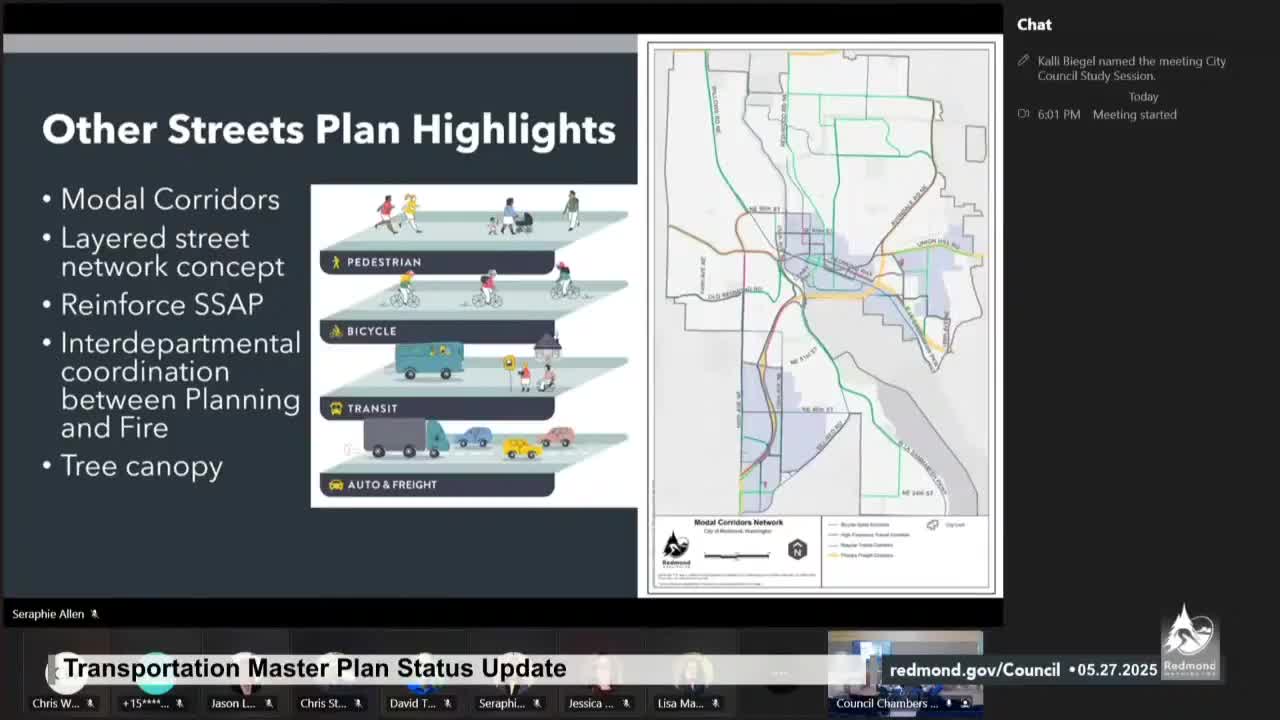Redmond Council advances street tree preservation policy and safer streets action plan
May 28, 2025 | Redmond, King County, Washington
This article was created by AI summarizing key points discussed. AI makes mistakes, so for full details and context, please refer to the video of the full meeting. Please report any errors so we can fix them. Report an error »

In the heart of Redmond's city hall, council members gathered under the warm glow of overhead lights to discuss pivotal strategies aimed at enhancing the city's infrastructure and environmental sustainability. The May 27, 2025, study session of the Redmond City Council focused on two key areas: the preservation of the tree canopy and improvements to public transit facilities.
A significant highlight of the meeting was the introduction of a comprehensive strategy to protect and expand the city's tree canopy within public rights-of-way. This initiative aligns with Redmond's 2050 policies and the Environmental Sustainability Action Plan (ESAP). Council members discussed the importance of assessing the value of street trees and the potential adoption of a street tree preservation policy. This policy would guide capital and development projects, ensuring that the city prioritizes the preservation of its green assets. The discussion also touched on the need for equipment and training to facilitate the relocation of trees, emphasizing the long-term benefits of maintaining mature trees over planting new ones.
Council Vice President Forsyth raised concerns about the current state of ADA-compliant metro stops, noting the lack of shelters and amenities. He proposed the inclusion of solar panels on these structures to enhance their functionality and appeal, particularly during darker hours. This suggestion sparked a conversation about collaboration with metro authorities to explore sustainable solutions for public transit facilities.
Another council member, Fields, introduced the idea of integrating technology into transportation planning. She highlighted the potential for a trip planner app that could combine various transportation options, such as biking, buses, and rideshares, to create a seamless travel experience for residents. This concept aligns with the city's broader transportation demand management strategies, which aim to reduce reliance on cars and promote alternative modes of transport.
The meeting also featured discussions on the implementation of roundabouts as a means to improve road safety and traffic flow. Council member Stewart expressed appreciation for the visual aids presented, which illustrated how roundabouts can reduce conflict points and lower vehicle speeds. The council's recent participation in the Puget Sound Regional Council's general assembly further reinforced their commitment to safe streets initiatives.
As the session concluded, council members reflected on the interconnectedness of these strategies, recognizing that the preservation of green infrastructure and the enhancement of public transit are essential components of a sustainable urban environment. The discussions set the stage for future collaborations and innovations that promise to shape Redmond's landscape for years to come.
A significant highlight of the meeting was the introduction of a comprehensive strategy to protect and expand the city's tree canopy within public rights-of-way. This initiative aligns with Redmond's 2050 policies and the Environmental Sustainability Action Plan (ESAP). Council members discussed the importance of assessing the value of street trees and the potential adoption of a street tree preservation policy. This policy would guide capital and development projects, ensuring that the city prioritizes the preservation of its green assets. The discussion also touched on the need for equipment and training to facilitate the relocation of trees, emphasizing the long-term benefits of maintaining mature trees over planting new ones.
Council Vice President Forsyth raised concerns about the current state of ADA-compliant metro stops, noting the lack of shelters and amenities. He proposed the inclusion of solar panels on these structures to enhance their functionality and appeal, particularly during darker hours. This suggestion sparked a conversation about collaboration with metro authorities to explore sustainable solutions for public transit facilities.
Another council member, Fields, introduced the idea of integrating technology into transportation planning. She highlighted the potential for a trip planner app that could combine various transportation options, such as biking, buses, and rideshares, to create a seamless travel experience for residents. This concept aligns with the city's broader transportation demand management strategies, which aim to reduce reliance on cars and promote alternative modes of transport.
The meeting also featured discussions on the implementation of roundabouts as a means to improve road safety and traffic flow. Council member Stewart expressed appreciation for the visual aids presented, which illustrated how roundabouts can reduce conflict points and lower vehicle speeds. The council's recent participation in the Puget Sound Regional Council's general assembly further reinforced their commitment to safe streets initiatives.
As the session concluded, council members reflected on the interconnectedness of these strategies, recognizing that the preservation of green infrastructure and the enhancement of public transit are essential components of a sustainable urban environment. The discussions set the stage for future collaborations and innovations that promise to shape Redmond's landscape for years to come.
View full meeting
This article is based on a recent meeting—watch the full video and explore the complete transcript for deeper insights into the discussion.
View full meeting
